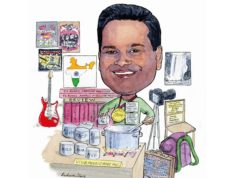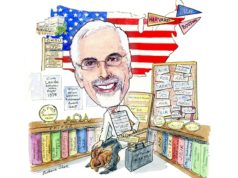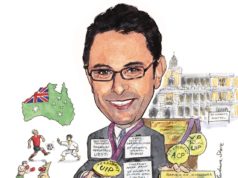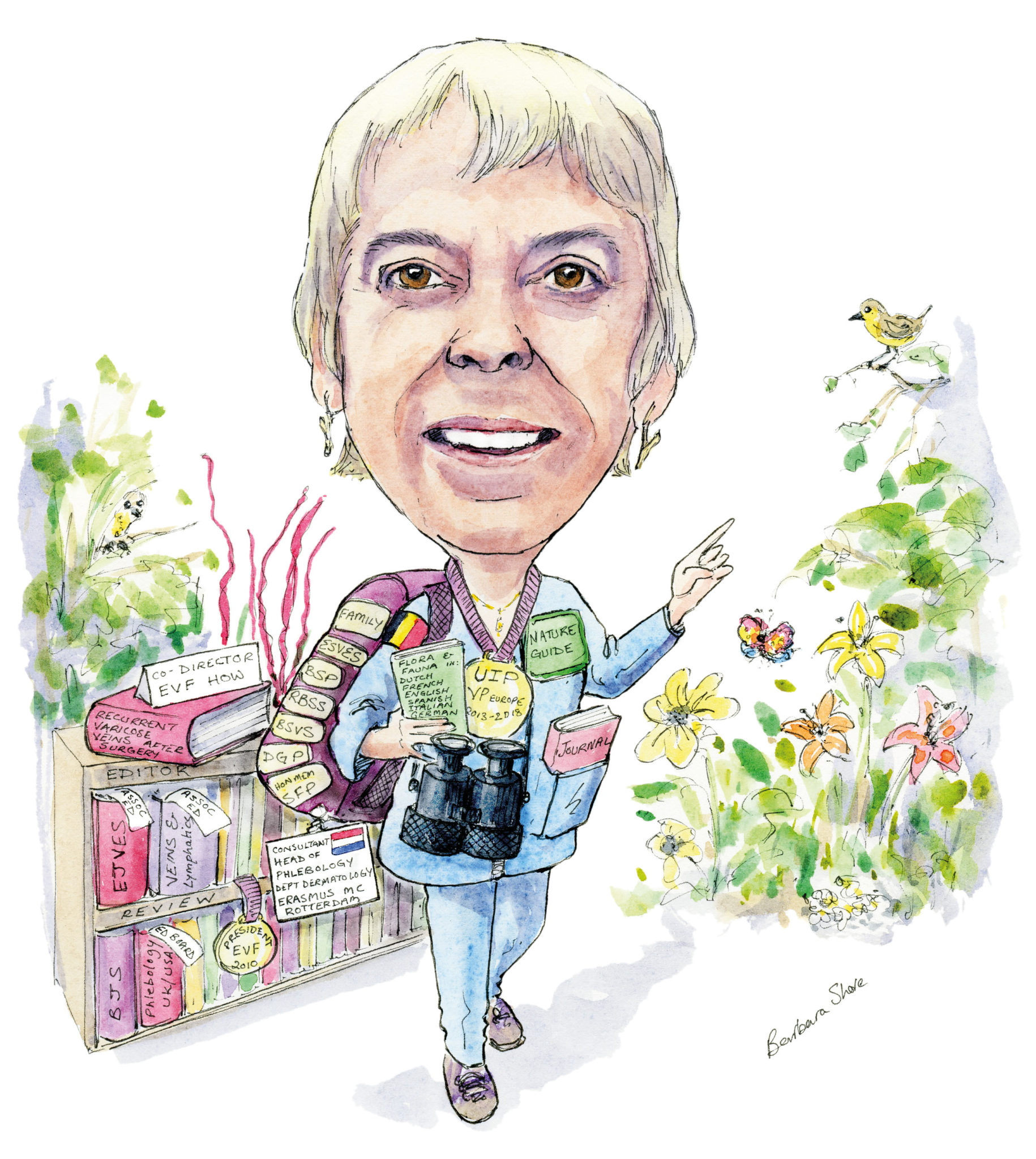 Marianne De Maeseneer already wanted to become a doctor by the age of 12, with her imagination captured by the idea of working in developing countries. A “series of coincidences” led her towards vascular and venous medicine, in which she decided to make a career. De Maeseneer spoke to Venous News about her journey to become a venous specialist, and shares some of the most notable experiences and lessons taken from her varied career.
Marianne De Maeseneer already wanted to become a doctor by the age of 12, with her imagination captured by the idea of working in developing countries. A “series of coincidences” led her towards vascular and venous medicine, in which she decided to make a career. De Maeseneer spoke to Venous News about her journey to become a venous specialist, and shares some of the most notable experiences and lessons taken from her varied career.
Why did you decide on a career in medicine?
At the age of 12, I already wanted to become a medical doctor. My initial idea was to work in a “developing country”, or the third world, as it was called at that time. In secondary school I was committed in the local social council and in the “youth parliament” of schools in my hometown of Ghent, Belgium. We organised project weeks, fund raising activities, peace marches etc. This is how I got in contact with several non-governmental organisations and how the idea grew to work with one of them as a MD later on.
It was logical to start medical training at Ghent University. During the last year of medical studies, I had the opportunity to follow a five-month course at the Institute for Tropical Medicine in Antwerp, always with a view to working overseas. I found these studies very interesting, and I very much liked the exchange with international students at the course. After finishing my studies, it was obvious that I had to get some surgical experience, to be prepared for the work in the field. In the meantime I was on a waiting list to leave with Médecins Sans Frontières. I started working in a general surgical practice to increase my surgical skills, first in Dendermonde and then at the Antwerp University Hospital, where there was an interim job vacant. I started enjoying surgery more and more. After some time. Professor Eric Schoofs, the head of the surgical department in Antwerp, asked me: “Marianne, did you ever think of becoming a surgeon?” This was of course a surprise for me. I gave it some thought, and, after an interval of a few months working and travelling in Peru and Bolivia, I eventually accepted! So this is how I fell into my surgical training in Antwerp, somehow by coincidence, but this is how it often goes in life.
Why vascular, and in particular venous?
That is another series of coincidences. During my sixth year of surgical training, I had to take over the vascular clinic temporarily together with another senior trainee, as our vascular consultant had left the Department and we were awaiting the new one. We managed to run the clinic, start up some non-invasive diagnostics (continuous-wave Doppler at that time) and do major vascular operations, with the general surgeons supervising us. This was really fun! Once I finished my training, I was asked to stay in the Department of Surgery in Antwerp, as vascular surgery was rapidly developing as a separate entity. Non-invasive diagnostics and veins became more and more my focus. Coming back from maternity leave, after the birth of my youngest son at the end of 1988, the Department bought a first colour duplex device, and I started scanning carotids, deep and later also superficial veins, more or less as a “self-made woman”, accompanied by the first edition of the book Introduction to Vascular Ultrasonography by W Zwiebel. In the vascular clinic, an increasing number of patients presented with venous problems, and soon I had to completely stop my arterial work, to only do veins. In addition, working as a surgeon with three little children and with my husband being an anaesthesiologist was not always an easy combination. The advantage of venous surgery was that this could be easily planned and that I could have a part-time activity, which was ideal for our little family.
Who have been your most important career mentors and what wisdom did they impart?
The first person playing an important role in my career has obviously been Prof Schoofs, who trained me as a surgeon. He was an excellent surgeon, and I did not only admire his technical skills (for example he was ambidextrous), from which I learned a lot, but also liked his positive approach. He made me feel confident, and taught me how important it is to feel good, at the end of an intervention. One should always try to leave the operating room thinking: “We have done a good job. We did the best we could do for this patient”. Now that I am training juniors myself, I realise how important it is to support them, give them positive feedback and to convince them they should always aim to do the best they can for each single patient.
I am full of admiration for Prof André van Rij from Dunedin, New Zealand, who used to lead a large vascular research group at the surgical department of the University of Otago. I got in contact with him at the time I finalised my PhD thesis on recurrent varicose veins after surgery, because his team was also studying varicose vein recurrence, and neovascularisation in particular, as I did. We first met at the third meeting of the Saphenofemoral Recurrence Research Group (SRRG) in Gloucester, UK, in May 2005. Thereafter I had the opportunity to meet him on several occasions during international congresses, and it was always fascinating to exchange ideas, starting with veins and moving far beyond! I like André’s “outside the box” thinking, resulting in original research projects, such as the study on neovascular veins, where they made resin casts of tissue blocks excised during a redo procedure in the groin. I also learned a lot from his presentations at meetings; he is very didactic, has no busy slides, and gets straight to the point.
A third person is Dr Olivier Pichot from Grenoble, France. He is a specialist in vascular medicine, or an “angiologist” as they use to call them in the south of Europe. He is an excellent sonographer and I had the opportunity to scan with him on several occasions, learning about all kinds of tips and tricks useful to improve my own skills in duplex ultrasound. We also have been collaborating for several research projects and publications. Olivier is a very creative person, he always comes up with new ideas and this is what I appreciate the most.
What has been the biggest development(s) in venous medicine during your career?
I think there have been three major developments in venous diagnosis and treatment during the last 30 years: first, the introduction of duplex ultrasound in daily venous practice, allowing for a detailed diagnosis of the specific “duplex anatomy” of each individual leg affected by chronic venous disease; second, the switch to mainly endovenous treatment of refluxing saphenous trunks; and third, the introduction of deep venous stenting for non-thrombotic or post-thrombotic iliac, iliocaval and iliofemoral obstructive lesions.
What is the most interesting paper or presentation that you have seen recently?
It is not easy to choose the most interesting paper, but I think one of the important articles recently published certainly is: “Factors associated with long-term outcome in 191 patients with iliofemoral DVT treated with catheter-directed thrombolysis”, chosen as Editor’s choice in the March 2017 issue of the European Journal of Vascular and Endovascular Surgery, written by Niels Bækgaard’s group. It is an observational cohort study, looking at the results of catheter-directed thrombolysis in a group of mainly young patients (median age 27 years, range 14–74 years) presenting with acute iliac or iliofemoral deep vein thrombosis. At the end of the lysis, a stent was placed in 106 limbs (52%). At seven years, the cumulative rate of patients with patent deep veins without reflux was 79%, which is an excellent result. Symptom duration less than two weeks and the absence of chronic post-thrombotic lesions at presentation were associated with the best outcomes. These are certainly promising results and should encourage us to at least consider a more invasive treatment in young patients presenting with extensive iliac, iliocaval or iliofemoral deep vein thrombosis (DVT). In my daily practice, unfortunately I still see too many young patients, under the age of 40, with invalidating post-thrombotic syndrome, venous claudication and/or chronic venous insufficiency including skin changes and even venous ulcers after conservative treatment for iliofemoral DVT. I often think they could have benefited from early thrombus removal, and feel sad about another missed opportunity.
What are your current research interests?
One of the main topics I studied recently, together with my PhD student Simone van der Velden (who finished her thesis successfully in June 2016), has been management strategies for patients with chronic venous disease, which is mainly about fine-tuning the treatment strategy, in view of the characteristics of each individual patient and the specific duplex ultrasound findings in the leg to be treated. Now that we have the evidence available about effectiveness of different treatment methods, which are reflected in recently-published international guidelines, I think we should move towards a more individualised approach; an à la carte treatment. Taking into account patient’s expectations, individual characteristics (comorbidities, anticoagulant treatment, etc.), symptoms (typically venous, or rather not), clinical signs (only varicose veins or more advanced chronic venous disease) and finally, the specificities of the duplex ultrasound findings, this all should help the physician to make the right decision, and plan an appropriate intervention. This should be as cost-effective as possible, and I am convinced this may even reduce the global costs for the care of patients with chronic venous disease. For example, at the moment, guidelines favour endovenous thermal (or non-thermal) ablation of the incompetent saphenous trunk as the solution for all patients. However, in properly selected patients, performing ambulatory phlebectomies only, in local tumescent anaesthesia (also known as the ASVAL procedure) might be a very valid—and cheaper— alternative. In view of this hypothesis, we have set up a large randomised controlled trial at Erasmus MC in Rotterdam together with some other centres in The Netherlands—the SAPTAP trial—to compare the effect of single ambulatory phlebectomies with thermal ablation of the refluxing saphenous trunk and phlebectomies. So far we have included 300 patients, with a view to a total sample size of 540.We hope to have preliminary results next year.
Another point of interest is in optimising the preoperative duplex ultrasound work-up in patients with chronic venous disease. We still need to look at more details, beyond just looking at reflux/no reflux of the saphenous trunks. Therefore, we studied the postural diameter change of the saphenous trunk, defined as the difference between the saphenous diameter while standing vs. while lying. Postural diameter change was lower with older age, increased body mass index, in limbs with C4–6 disease, and in larger diameter veins (>7mm). It would be worthwhile to investigate this duplex parameter further in prospective studies to determine its value in determining management strategy. The same is true for vein wall thickness, focal dilatations of the saphenous trunk etc. In daily practice, more and more patients are referred to our department with post-thrombotic syndrome and therefore our future research will mainly focus on prevention and treatment of this condition, which has a negative impact on quality of life. First we need better tools to define post-thrombotic syndrome, as the presently used Villalta scale is not completely satisfactory. Second, diagnostic protocols should be optimised. We perform a lot of abdominal duplex ultrasound of the iliocaval system at our centre, but the investigation protocol still needs improvement and it should be better defined whether and when we need additional phlebography, computed tomographic (CT) venography, magnetic resonance (MR) venography and intravascular ultrasound, to reduce unnecessary costs. Third, more work should be done to determine in which patients stenting of post-thrombotic obstructive lesions should be considered. As often very young patients are concerned, we need to look at a long-term perspective.
Finally, I am quite intrigued by a rather rare condition, which has been called absence or atresia of the inferior caval vein, leading to unilateral or bilateral iliofemoral DVT at young age. Probably inferior caval vein thrombosis at very young age also plays a role, and we should try to understand this condition better. At Erasmus MC, we are following up about 40 young patients suffering from this rare condition.
Is there still a place for open surgery in varicose vein treatment?
First of all, one should realise that open surgery for varicose veins is still very popular worldwide. Even in several European countries, surgery remains the most commonlyused treatment form, mainly because of reimbursement conditions. In addition, it should be acknowledged that long-term results of well-performed open surgery are similar to those of endovenous thermal ablation, while both are superior to ultrasound-guided foam sclerotherapy, according to randomised controlled trials with at least five years of follow-up; surgery is a durable method, there is no doubt about that. Of course, there may be slightly more short-term morbidity and return to work/normal activity may be a little bit slower, but this does not affect long-term efficacy. One of the important disadvantages is that open surgery has to be performed in an operation room, whereas endovenous treatments can be performed in a strictly ambulatory setting and even in a simple treatment room (if permitted by local health care regulations). The latter may represent an important cost saving. In addition, it should be mentioned that, in some of the recently published long term follow-up data patients allocated to surgery were operated on under local tumescent anaesthesia. The latter is often called “modern varicose vein surgery”.
In countries were endovenous treatments have become the treatment of choice for saphenous incompetence, there is only a very small place left for open surgery. I see only two indications: in case of a large saphenous aneurysm (>3cm diameter) close to the saphenofemoral or saphenopopliteal junction, where high ligation may be performed to avoid thromboembolic complications, and in case of extremely thin patients, with a distance between the saphenous trunk and the skin of only 1mm or 2mm, where stripping may still be preferred.
You coordinated publication of the Union Internationale de Phlébologie (UIP) consensus document on duplex ultrasound reporting after varicose vein treatment. Does the use of duplex ultrasound vary globally?
In most Anglo-Saxon and Scandinavian countries duplex ultrasound is mainly performed by vascular technologists, who work in close collaboration with a (vascular) surgical department. They have specific training, examinations and may obtain a degree, for instance of registered vascular technologist. The more these technologists obtain experience in venous work, and the closer they are involved with different clinical presentations of patients with chronic venous disease, the better they become, and some of them are really outstanding. Nevertheless, venous duplex ultrasound is not easy. In contrast to arterial anatomy, venous anatomy is sometimes very complex, in particular in case of recurrent disease. Moreover it is also quite demanding to unravel deep venous problems. In many other countries duplex ultrasound is performed by the medical doctors themselves, usually specialists in angiology, (vascular) surgery, dermatology, etc., who are able to directly link the duplex findings to the clinical condition of a patient and decide on an appropriate treatment strategy. I think it is indeed very important that physicians who want to treat patients with venous disease are able to perform a duplex scan themselves. For this reason, in our yearly organised comprehensive three-day course on venous disease, the European Venous Forum Hands-On Workshop, the delegates always have the opportunity to improve their duplex skills during four half-an-hour workstations with real patients. The aim of the UIP consensus documents on duplex ultrasound (including the two previous ones published in 2006) was mainly to introduce a methodology which could be applied worldwide, and could help physicians “speak the same language”. Looking at the international literature, there is still a lot of confusion in reporting duplex ultrasound findings. Just an example, in studies on varicose vein treatment, often preoperative diameter measurement of, for instance, the great saphenous vein is mentioned. However, this can be measured at different sites, and sometimes the largest diameter is taken into account like in the CLASS trial, which makes it difficult to compare with other studies.
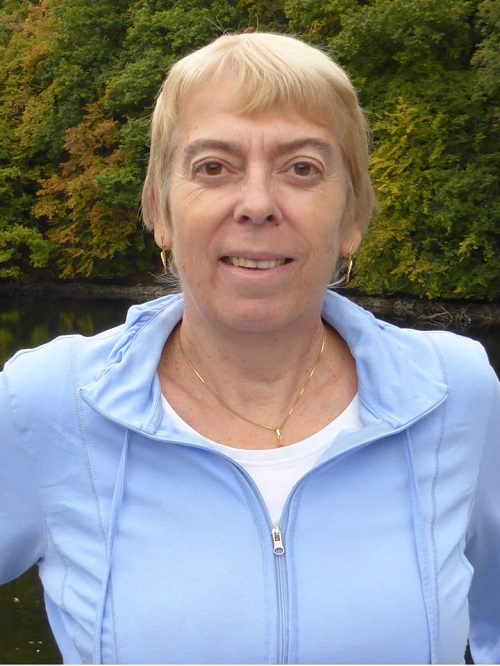
Do you see other modalities replacing duplex ultrasound in the future?
No, although CT and MR imaging are increasingly used in venous practice, they will never really replace duplex ultrasound; the latter will always be used in daily venous practice for screening and diagnosis, as it is absolutely non-invasive, relatively cheap and safe, without the need for using contrast, without radiation etc. It allows real-time investigation of venous haemodynamics. Hence in most patients suffering from chronic venous disease, diagnosis can be made completely by means of duplex ultrasound alone. In patients presenting with varicose veins (C2) and/or venous oedema (C3) examination should be performed in the standing position to detect reflux, so there is no point of replacing duplex ultrasound with CT or MRI there! Moreover nowadays ultrasound is needed for most procedures used to treat superficial venous incompetence, as most of them are ultrasound-guided (vein puncture, application of tumescence, evaluation of vein spasm when applying foam etc.).
In selected patients suffering from more advanced chronic venous disease (mainly C4–C6), duplex ultrasound can of course be extended above the inguinal ligament to investigate iliac veins and the inferior vena cava. In certain cases, this will have to be complemented by additional radiologic investigations like CT and MR imaging, especially if deep venous interventions like angioplasty and stenting are considered.
Data from the ATTRACT trial has recently been announced, failing to meet its primary endpoints – what impact do you think that this will have on venous practice?
I agree the global incidence in post-thrombotic syndrome was not different, but there was a 25% reduction in the incidence of moderate to severe post-thrombotic syndrome. Lots of discussions have been going on since the first report by Suresh Vedantham at SIR in March 2017. I think these discussions are very important, not only between vascular surgeons but also as part of interaction with internal medicine specialists, who, in many hospitals, are still taking care of patients with DVT and tend to be more conservative. It will certainly open up the discussion and increase the awareness about the possibility of interventional treatment. In highly symptomatic patients with iliofemoral DVT, important swelling of the thigh and low risk of bleeding in particular, early clot removal should be at least considered. Hopefully further analysis of subgroups may show the benefit of interventional treatment in these patients and this may change future guidelines. Probably the long-term results (at least five years) will be more convincing, as severity of post-thrombotic syndrome increases with time.
The results of the ATTRACT trial confirm my idea that nowadays we should not use the term “proximal DVT” anymore. We should define the extent of DVT better from the start, at least distinguishing between iliofemoral and femoropopliteal DVT. Although the term “iliofemoral DVT” was used in the 2008 version of the ACCP guidelines, in the 2016 version it was not mentioned at all! It was rather sad to see only the term proximal DVT appear there. As I discussed in a paper in EJVES last year, this should be changed in the future, to better stratify patients with DVT and select those who could benefit from interventional treatment.
What are some of the main challenges facing specialist venous training in Europe?
The importance of venous training has long been underestimated in the training of vascular surgeons and of other specialties. There are several challenges to be met. In European countries, many different specialists take care of patients with venous disease: vascular surgeons, vascular medicine specialists (angiologists), dermatologists, and recently an increasing number of interventional radiologists, depending on the country and local situation. So, to set up venous training applicable throughout Europe, we need to conciliate, or at least bring together all these different specialties. Lots of efforts are ongoing in view of introducing a proper training in phlebology within the European Union of Medical Specialists. European structures are extremely complex, with a large number of rules to cope with. Recently the European Board of Phlebology has been created, which is in charge of meeting these challenges. It will be a long distance run, but I am confident that the members of this board eventually will come up with a venous curriculum, a plan for training sessions in clinical practice, workshops, etc., and eventually examination and certification. Phlebology will never become a separate specialty, but will be a subspecialty with its own requirements. In the USA and Australia, similar efforts have already been made, but of course they have the advantage of being one big country, all speaking one language. In Europe, we have all the different languages, national regulations etc. which also represent a major challenge. An international educational initiative, for instance the yearly EVF hands-on workshop (the organisation of which I am personally involved in), may become part of the venous training programme, together with other initiatives.
Could you tell us about one of your most memorable cases?
One of the cases I will always remember dates from 1998, when I was working at the Department of Thoracic and Vascular Surgery at the Antwerp University Hospital in Belgium. I operated on a 63-year-old obese lady (BMI>35), who not only had extensive recurrent varicose veins, but also a hanging belly. I had planned to perform a redo high ligation in the groin, and I remember the nurses had to fix the belly with straps for me to be able to reach the groin. She left the hospital one day after the procedure. Two days later she called her GP because she had 39-degree fever. The GP told her it was probably only flu and she should take some aspirin. He did not visit her, as he was too busy. A day later her son found her with high fever, dizziness and even some mental confusion. At the emergency department I saw her with a massive wound infection in the operated groin, skin necrosis around it and, obviously, sepsis. After re-opening the groin incision and cleaning the whole mess, her clinical condition improved immediately, and fortunately she recovered well, without further complications.
What did this experience teach me? First, to think twice before planning a redo procedure in the groin, particularly in obese patients. By the way, nowadays there are hardly any indications left for redo surgery in the groin for recurrent varicose veins, as many less invasive alternatives are available. Second, to tell a patient he or she should contact the surgeon/surgical department, in case of high fever (or other problems) after a varicose vein intervention, not the GP. Third, for the GP, and for all physicians, practising medicine by phone, without seeing the patient, is always a bad idea.
What are some of the proudest moments in your career?
The proudest moment for me was when I defended my PhD thesis, a few months before my 50th birthday. Not only my husband, but also our three children (adolescents at that time) were in the audience, together with more family, colleagues, neighbours and friends. It was such a joy for me to tell them about my research (on recurrent varicose veins), share my enthusiasm with them, defend my case well and then celebrate with a glass of wine! I remember, it was on St. Valentine’s Day, 14 February, and so, when we went out for dinner with the members of the jury in the evening, we ended up having a typical Valentine dinner, with romantic decorations, little red hearts and so on—a little unusual for an official dinner!
I was also very proud when my name was suggested to become associate editor for the venous submissions to the European Journal of Vascular and Endovascular Surgery, taking over from Michael Gough. It has been a real honour and pleasure for me to collaborate closely with the previous editor-in-chief Ross Naylor and now with Philippe Kolh, and of course with all my colleague editors.
What three questions in venous medicine still need to be answered?
In patients with superficial venous incompetence, the question is which management strategy is the most cost-effective? Efficacy of treatments has been proven but cost is now a major issue worldwide. In some patients, no treatment or a limited treatment may also be a good approach, so we should look at the economic impact on the health care budget, which becomes increasingly important.
For patients with acute DVT, as discussed above, we need to determine how to select the proper patients for early clot removal? The ATTRACT trial was only a start.
The third question I would raise is how can we further reduce the number of patients with venous ulcers in the general population and how to improve care for these patients? This is the final goal of all efforts in chronic venous disease.
Of course there are much more questions to be answered; venous medicine is still young!
What advice would you give to young surgeons starting out in their careers?
First of all, enjoy what you are doing! Whether you work in a small hospital or in a large academic centre(it does not matter which) work with commitment and passion. Listen carefully to your patients, take your time for a careful clinical examination and do not immediately jump to all kinds of technical investigations. When operating, always try to do the best you can for every single patient. Know your own limitations; you cannot solve everything. If things go wrong, try to understand what happened, look it up in the literature and, not to forget, share your feelings about what occurred with a colleague you trust. Remain curious, you can always learn something new from a particular case. Start or continue to join research, it is fascinating. Go to a scientific meeting, course, workshop, also internationally, from time to time. Visit a colleague; this can be really interesting.
Last but not least, try to find a good balance between work and family life, this is essential!
Outside of medicine, what are your interests?
First of all I like to spend time with my family, that is always fun! I also love to be out in nature, exploring and discovering wonderful places, together with my husband. For us, outdoors activities are ideal for relaxing. Travelling and meeting local people is another passion; there are still a lot of destinations on my list!
Fact file
Education (selected)
1976 Candidate Medicine, Rijksuniversiteit Gent, Ghent, Belgium
1980 Doctor of medicine, Rijksuniversiteit, Gent, Ghent, Belgium
1980 Tropical medicine, Institute for Tropical Medicine, Antwerp, Belgium
1987 General Surgery, Antwerp University, Antwerp, Belgium
2005 Doctor in Medical Sciences, Antwerp University, Antwerp, Belgium
Previous positions (selected)
1980–1981 Surgical trainee, General Hospital Dendermonde, Dendermonde, Belgium
1981–1987 Surgical trainee, University Hospital Antwerp, Antwerp, Belgium
1987–1988 Consultant in General and Vascular Surgery, University Hospital Antwerp, Antwerp, Belgium
1988–2010 Consultant in the Department of Thoracic and Vascular Surgery, responsible for Phlebology, Venous Surgery and Duplex Ultrasound, University Hospital Antwerp, Antwerp, Belgium
2007–2015 Associate Professor of Surgery at the Faculty of Medicine and Health
Sciences, Antwerp University, Antwerp, Belgium
2010–2017 Consultant, Head of Section Phlebology at the Department of Dermatology, Erasmus MC, Rotterdam, The Netherlands
Editorial positions (selected)
- Associate Editor (Venous Disease), European Journal of Vascular and Endovascular Surgery
- Associate Editor, Veins & Lymphatics
- Reviewer, British Journal of Surgery
- Reviewer and member of the editorial board, Phlebology
International commitments
- Co-director of the yearly Hands-on Workshop of the European Venous Forum (EVF HOW)
- Vice President of the International Union of Phlebology (Union Internationale de Phlébologie)

